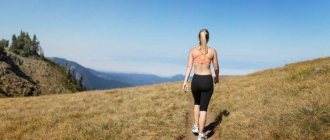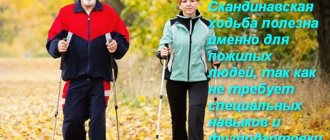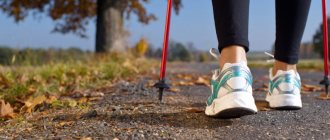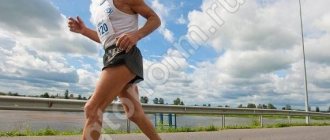Health path is one of the types of sanatorium-resort treatment. The complex includes physical therapy, climate and landscape therapy. To put it simply, a health path means walking along routes specially developed by exercise therapy and physical education (therapeutic and health-improving physical culture) specialists. In this case, the distance, pace and angle of inclination of the terrain are strictly measured. It is useful for people of different ages to become familiar with the indications for this treatment method and its effect on the body.
Therapeutic walking - what is it?
We all walk certain distances every day at different paces, at different speeds for different periods of time. However, not everyone knows when a walk is beneficial and when it has no effect on the body’s condition. The fact is that there are three types of walking: normal, dosed and accelerated.
- Regular walking to some extent accelerates metabolic processes in the body, normalizes the functioning of the heart, blood vessels and respiratory organs, and stabilizes the psycho-emotional state.
- Dosed walking strengthens the cardiovascular system and trains the musculoskeletal system.
- Accelerated walking is characterized by increased energy consumption, a gradual increase in muscle mass and makes the human body more resilient.
Ordinary walking, as a rule, does not give a clear effect to healthy, physically fit people. For them, such loads are considered too light. But it helps elderly, weakened patients regain strength and smoothly transition to measured walking.
Walking speed will tell you about the health of the body
American researchers have concluded that a measurement of walking speed should be added to the list of health indicators. Moreover, they are confident that life expectancy can be predicted based on walking performance. American cardiac surgeons suggested using this indicator for:
- identifying patients who are likely to have difficulties in the postoperative period;
- marker of heart pathologies and cognitive impairment.
Important! The more sick a person is, the less strength he has to move quickly.
Scientists have identified diseases that can change a person’s gait and speed of movement:
- problems with the cardiovascular system;
- Cerebral palsy, multiple sclerosis, Parkinson's disease;
- poor posture;
- intellectual fatigue of the student;
- atherosclerosis;
- cholesterol plaques;
- spinal hernia;
- stenosis of the intervertebral canal.
Impact on the body
Despite the ease of implementation, therapeutic walking has a complex effect on human health. It improves the functioning of all body systems, from the respiratory system to the muscles of the legs. Let's highlight the main positive points:
- Normalization of respiratory function;
- Blood oxygen saturation;
- Strengthening the muscles of the limbs and body;
- Hardening;
- Increased immune defense;
- Improved coordination of movements;
- Toning the cardiovascular system;
- Increased endurance;
- Improving blood flow from the lower extremities, preventing edema;
- Activation of metabolic and energy processes;
- Weight loss;
- Increased stress resistance;
- Improved mood, psychological relief.
Thanks to such multidirectional effects, such training is prescribed for both therapeutic and preventive purposes. For healthy people, walking has a tonic and general strengthening effect, as a result of which they are less likely to suffer from viral infections and cardiovascular diseases.
Indications
Indications for dosed walking are equally varied:
- Bronchial asthma;
- Chronic obstructive pulmonary disease;
- Recovery after pneumonia;
- Metabolic diseases;
- Obesity;
- Osteochondrosis;
- Changes in blood pressure;
- Recovery period of stroke, heart attack, injuries;
- Vegetative-vascular dystonia;
- Pregnancy;
- Mental instability;
- Sedentary lifestyle.
Methods of therapeutic walking vary for the listed conditions; they must be agreed upon with a doctor. In particular, for bronchitis, osteoarthritis of the knee and hip joints, pregnancy, after a heart attack, stroke, coronary artery stenting, a leisurely pace of walking and a more gradual increase in loads are recommended.
Note!
Contraindications to dosed walking are acute infectious diseases, any decompensated pathologies of internal organs, acute stage of heart attack, stroke, pneumonia, etc.
Walking pace
For therapeutic purposes, you can walk at different speeds. The recommended pace depends on the patient's condition and initial physical fitness.
- A very slow pace is characterized by low speed - up to 70 steps per minute or 3 km/h;
- At a slow pace, the patient moves at a speed of 70-90 steps per minute. (3-4 km/h);
- By average pace we mean a moving speed from 90 to 120 steps per minute, which corresponds to 4-5.5 km/h;
- At a fast pace, a person walks at a speed of 120-140 steps per minute (or 5.5-6.5 km/h);
- Walking pace over 140 steps per minute. (6.5 km/h) is considered very fast.
As a rule, in the initial stages it is recommended to walk at your usual pace, and increase it every 3-5 days. However, this advice is not universal: it all depends on the condition of a particular person and his tolerance to physical activity.
The development of the transport system in large cities, as well as the presence of a car in almost every family, has minimized the need to walk. In the current conditions, undoubtedly, these factors have a positive meaning, since they allow you to save time when there is a chronic lack of it. But, as you know, every medal has two sides. A decrease in physical activity leads to a steady increase in the number of diseases associated with hypokinesia. Excess body weight and musculoskeletal disorders are just some of the health problems that arise at school age and are directly related to insufficiently and irrationally organized motor activity of children. Childhood obesity, which is a high-risk factor for the development of cardiovascular diseases (CVD), is a generally recognized medical problem.
According to V.A. Peterkova and O.V. Remizov, in the Russian Federation, an average of 5.5% of children living in rural areas and 8.5% of those living in the city suffer from obesity [1]. Obese adolescents remain overweight 50–70% of the time as adults. As a result, existing diseases progress with age. Excess body weight leads to the development of diseases of the cardiovascular and respiratory systems, pathological processes in the spine, and functional disorders of internal organs. Thus, CVS disorders are detected on average in 60% of young people. According to research results, due to health reasons, 40–45% of students are enrolled in a special medical health group [2, 3].
According to WHO, physical inactivity is the main cause of approximately 30% of cases of coronary heart disease, 27% of diabetes cases and increases the risk of developing breast and colon cancer by 21–25% [4].
Low physical activity also contributes to the lack of commitment to a healthy lifestyle in the family. According to Japanese researchers, maximum physical activity is observed at the age of 30–39 years and is 8240 steps per day for men, 7233 for women. Further, with age, there is a decrease in motivation for physical activity due to psychological reasons, as well as due to deterioration of health, there is a decrease in locomotor activity by an average of 700 steps for every 10 years of life [5]. Thus, in the current social and living conditions, there is a need for additional physical education classes.
Currently, in cities there is a fairly widely developed network of fitness centers, gyms and other sports facilities that make it possible to fulfill the need for physical education and sports. But this does not solve the problem of low physical activity, since often the services of fitness centers are expensive or lack of time makes it impossible to visit them. The resulting deficit in physical activity can be compensated for by such a natural method of physical activity as walking. Walking is the simplest form of physical exercise available to every person, regardless of age and living conditions. Walking does not require any special equipment, conditions, material and technical equipment or financial costs, and in combination with natural factors (sun, fresh air), the beneficial effects of walking are only enhanced. As is known, in the conditions of insurance medicine there is a reassessment of existing methods of disease prevention not only from the point of view of their clinical effectiveness, but also taking into account economic factors [6]. Thus, an analysis of the clinical and economic effectiveness of long-term physical training methods in patients with cardiovascular pathology revealed that physical training by walking at an arbitrary pace has the optimal cost-effectiveness indicator [7, 8].
For a more complete understanding of walking as an act of motor action, it is necessary to consider it from the point of view of dynamic anatomy and biomechanics, and the mechanism of energy supply during walking and its effect on the human body - also from the point of view of normal physiology and biochemistry.
Walking is the most common type of locomotion, the purpose of which is to move a person. Walking is an automated motor act that occurs as a result of complex coordinated activity of the skeletal muscles of the trunk and limbs. The entire human musculoskeletal system is involved in walking, and the main force that ensures the movement of the body is muscle strength [9, 10].
Walking is a complex cyclic locomotor action, one of the main elements of which is step. When walking, the body moves in space due to the interaction of internal and external forces (muscle traction force, body weight, ground reaction force, etc.). In each step, there is a period of support and a period of swing. Each of these periods is divided into two main phases: the support period - into the phases of the front and rear push, and the swing period - into the phases of the back and front step [11].
The first phase of walking - the phase of front support (depreciation) - begins with placing the front foot on the heel and ends with the moment of the vertical position of the supporting leg, the body advances due to the rear push of the second leg. The second phase - the rear support (push-off) phase - begins from the moment the supporting leg is vertical and ends with the moment it is lifted from the support. This phase is the main one, ensuring forward movement, creating conditions for maintaining balance, and ensuring the transfer of the leg in the next two phases. The third phase - the back phase of the swing (back step) - begins from the moment the pushing leg lifts off the support and ends with the moment of its vertical position, the lifting and “acceleration” of the free leg occurs. The fourth phase - the front phase of the swing (front step) - begins with the vertical position of the free leg and ends with the moment it is placed on the heel. The full cycle of walking movements is a double step, consisting of two single steps. The total volume of muscular work when walking is large, almost all the muscles of the body are involved, especially the more powerful muscle groups, and the dynamic nature does not cause rapid fatigue. Distinctive features of walking compared to running are the constant supporting position of one or both legs and the absence of a flight phase.
The muscular component of the complete motor walking cycle is presented in the table.
The upper limbs also take part in the act of walking. When the right leg is brought forward, the right hand moves back, and the left hand moves forward [10].
Consistent alternation of contraction, relaxation and stretching of various muscle groups while walking contributes to the slow development of fatigue. Rhythmic body movements improve blood circulation in all organs and ventilation function of the lungs. This is why walking is the optimal form of physical activity [6].
According to the mechanism of energy supply, walking is a low aerobic power exercise, with oxygen consumption of 50% or less of the individual maximum oxygen consumption (MOC). When walking, almost all the energy of the working muscles is provided through oxidative processes, in which predominantly fats and, to a lesser extent, carbohydrates are consumed. That is why when walking for several tens of minutes there is a decrease in the concentration of glucose in the blood. Exercises of this relative physiological power can be performed for many hours without causing fatigue. When walking, for each kilometer of distance, an average of 0.72 kcal/kg of body weight is consumed in women and 0.68 kcal/kg of body weight in men. The estimated energy consumption when walking at a speed of 3 km/h is 2 kcal/min, at a speed of 5 and 7 km/h – 4 and 7 kcal/min, respectively. When walking, the average load power or speed of movement over a distance is relatively constant. The leading physiological systems and mechanisms that ensure the walking process are the oxygen transport system and the aerobic capabilities of working muscles [6,12,13].
The most common means of preventive and restorative medicine is such a natural form of physical therapy as dosed walking (WW) [12, 14].
DH is carried out on flat terrain, starting with a route length of 1000 m. There are the following walking speed options:
very slow – 60–70 steps/min, or 2.5–3 km/h;
slow – 70–90 steps/min, or 3–3.5 km/h;
average – 90–120 steps/min, or 4–5.6 km/h;
fast - 120–140 steps/min, or 5.6–6.4 km/h;
very fast - more than 140 steps/min, or over 6.5 km/h.
At the beginning of treatment with movement, it is advisable to walk at a pace characteristic of the patient, and if walking is well tolerated, physical activity should be gradually increased every 3–5 days by increasing the distance or accelerating the pace of walking.
The use of DH must be carried out taking into account the following rules:
Walking should be regular, a daily regimen is optimal.
The duration of walks (distance, time) should be increased gradually, depending on tolerance.
The patient’s subjective state at the end of the walk should be characterized by good health and slight pleasant fatigue.
An individual approach is the main requirement for health training. The principle of individualization is the strict correspondence of physical activity not only to the functional, but also to the personal characteristics of the patient, determined by age, gender, and state of health. The success of the rehabilitation program is largely associated with increasing the duration of the load, and to a lesser extent with increasing its intensity. When planning the pace of walking, one should take into account age-related changes in a person’s gait and balance, a decrease in the strength and endurance of the muscles of the lower extremities with age, which affects the maximum permissible walking speed without the risk of injury and falls. If there are risk factors, the intensity of the load should be reduced [15, 16].
Before starting to use DH, it is necessary to conduct load testing. The most suitable for untrained people is a 6-minute walk as fast as possible, but without shortness of breath when talking to the instructor during or after it. This test is often used to determine aerobic capacity in older adults with varying health conditions [17, 18].
Aerobic exercise in the form of physical activity is safe both for older people and for other high-risk groups (for example, at any age - for detrained people suffering from obesity or cardiovascular diseases). Individually optimal physical activity is prescribed to improve health and quality of life, expand the functional capabilities of the body, increase endurance and psychological stability, as well as for primary and secondary prevention of diseases and reduce mortality [19–21].
Moderate physical activity in the form of physical activity is a preventive measure against many diseases. Many positive systemic effects of walking have been described: it has a significant positive effect on the course of cardiorespiratory diseases, immunity, the state of the gastrointestinal tract (GIT) and musculoskeletal system, reduces the risk of cancer, and most importantly, improves the quality of health and increases life expectancy [22–28]. Thus, the positive effects of walking were confirmed by the results of a meta-analysis of studies conducted by scientists at University College London. The researchers analyzed 4,295 publications in peer-reviewed English-language journals from 1970 to 2007. In total, these studies evaluated 459,833 participants from seven countries on three continents who were apparently healthy and free of cardiovascular disease (CVD) before the study. Each study collected information on risk factors (age, smoking, alcohol consumption, etc.).
Study participants were followed for an average of 11.3 years, during which CVD events (angina, myocardial infarction, heart failure, stroke) were recorded and life expectancy was assessed. The results concluded that walking reduced the risk of cardiovascular disease by 31% and reduced the risk of death during the study by 32%, regardless of the gender of the participants. Among the 10,269 men in the study who walked 9 miles per week, the death rate was 22% lower; among 44,452 men who walked at least 30 minutes per day, the risk of coronary artery disease was 18% lower; among 72,488 women who walked 3 hours per week, a 35% reduction in the risk of heart attack and cardiac death and a 34% reduction in the risk of stroke were found [29, 30]. Based on this, it was concluded that walking has a comprehensive positive effect on human health.
For a deeper understanding of the positive effect of walking on the body, it is necessary to consider the mechanism of the influence of physical activity separately on organs and systems.
Walking has an effect on the state of the central nervous system, activating the activity of all brain zones, promoting their normal functioning, as a result of which people who walk have improved motor skills and coordination, improved blood circulation in the brain, which contributes to the enrichment of nerve cells with oxygen and their accelerated recovery. Walking reduces the risk of depression by 30% and Alzheimer's disease by 40–45% [14, 30–32].
The influence of walking on the state of the autonomic nervous system has also been proven. As is known, the coordinated activity of the sympathetic and parasympathetic nervous systems ensures fine regulation of the functions of internal organs and metabolism. Increased activity of the sympathetic nervous system causes increased heart rate and increased blood pressure, while the parasympathetic nervous system, on the contrary, slows down cardiac activity. Walking increases the tone of the vagus nerve and helps reduce the tone of the sympathetic nervous system, which ultimately reduces the risk of sudden death. The autonomic nervous system is the most important system that has a great influence on the functional activity of the heart. In this regard, walking is widely used for the purpose of primary and secondary prevention of CVD [16, 24, 33].
DH is prescribed for the purpose of improving the health and increasing the functional capabilities of the body, developing adaptive mechanisms of the cardiovascular system. Moderate physical activity, individually dosed, can be recommended for all people, even if they have several risk factors for cardiovascular diseases. The effect of cardiovascular endurance training using walking is to normalize blood pressure in people with hypertension. Low intensity mode (100–110 beats/min), characteristic of recreational walking, significantly reduces diastolic blood pressure. It has also been proven to reduce the risk of paradoxical vasoconstriction of coronary vessels affected by atherosclerosis, increase myocardial perfusion, and improve endothelial function. Walking has an antiarrhythmic effect by stimulating vagal activity and reducing the tone of the sympathetic nervous system [27, 33–36].
Numerous studies have proven that moderate-intensity physical training is the most physiological and justified method of cardiac rehabilitation. The use of walking in patients with coronary artery disease after endovascular revascularization is recommended as a method of physical training that helps maintain a high level of clinical effectiveness of rehabilitation measures at the outpatient stage [16, 20, 37–39].
DC is recommended as a measure of primary and secondary prevention of peripheral vascular diseases: obliterating endarteritis, varicose veins, lymphovenous insufficiency. It is known that the life expectancy of men with obliterating lesions of the arteries of the lower extremities is on average 10 years less than in the general population. The so-called pumping function of the muscles of the lower extremities, consisting of a rhythmic alternation of tension and relaxation, improves blood and lymph circulation, which prevents the occurrence of congestion in the lower extremities. This effect is based on an increase in the energy capacity of mitochondria in the muscles of the lower extremities in response to systematic aerobic exercise, the opening of anastomoses and the formation of new capillaries, increased resistance to hypoxia and fibrinolytic activity of the blood [31, 36, 40, 41].
The effect of walking on the functional state of the respiratory system is to improve pulmonary ventilation and increase the tidal volume of the lungs. After physical exercise in the form of walking at a heart rate of 100–110 beats/min, the values of maximum expiratory flow rate (PEF), maximum voluntary ventilation (MVVind), forced expiratory time (FET) and tidal volume (TV) significantly increase [42] .
Since with increased physical activity the muscles of the upper half of the body are involved in the act of breathing, an increase in lung excursion occurs, which leads to an increase in oxygen consumption by up to 30%. Intense breathing helps to expand the pulmonary capillaries, the lumen of the bronchioles and alveoli, and normalize gas exchange. Increased mobility of the chest and diaphragm leads to stretching of pleural adhesions, removal of sputum, and reduction of congestion in the lungs in people with chronic diseases of the respiratory system [3].
As already noted, during cyclic aerobic exercise of low and medium intensity, the energy of working muscles is provided primarily by the oxidation of fats, and to a lesser extent by carbohydrates, which affects metabolism and the activity of the endocrine system. That is why when walking there is a decrease in the concentration of glucose in the blood, which is an important factor in the prevention and prevention of the development of type 2 diabetes mellitus [43].
The mechanism of energy supply to walking, mainly due to fat oxidation, largely determines the effectiveness of walking in reducing body weight in obese patients. A study by Thompson et al. found that middle-aged women who walked 10,000 steps per day had normal body mass index, waist circumference, waist-hip ratio, and body fat percentage [44]. Systematic walking exercises increase the level of high-density lipoprotein (HDL) and reduce the concentration of triglycerides, which prevents the development of atherosclerosis. A study conducted by a group of scientists at the University of Washington showed that the use of low-intensity physical activity in patients with excess body weight and impaired cholesterol metabolism in the form of walking at a heart rate equal to 60% of the maximum, with a frequency of 5 times a week and a duration of 30 minutes, increases BMD by 12% compared to the initial level, reduces blood cholesterol levels, and increases HDL levels by 14% [31, 45].
Relatively low-intensity physical activity, such as walking, has a protective role for the gastrointestinal tract and liver. A number of studies have revealed the protective role of physical activity in relation to the risk of gallstone disease and constipation, mainly due to increased motility of the gallbladder and intestines. When studying the effect of a 15-minute walk on gastric motility, it was shown that it increases compared to rest when walking at a speed of 1.57 m/s at a load power of 28–56% of MPC. Regular muscle activity can promote the healing of stomach and duodenal ulcers by normalizing microcirculation in the area of the ulcers. Muscle exercise can reduce the risk of diverticulosis, colitis and gastrointestinal bleeding. People who walk have a lower risk of Crohn's disease and gastrointestinal cancers than those who are sedentary, regardless of other factors such as age, gender, high body mass index or health status. It has been shown that daily physical activity reduces the risk of this pathology to a greater extent than weekly physical activity. It is assumed that the reduction in the risk of gastrointestinal cancer occurs due to the activation of intestinal function during walking and strengthening of its motility, especially in combination with a diet high in dietary fiber, as well as due to more intense contraction of the abdominal muscles, which are auxiliary respiratory muscles. An increased content of coarse dietary fiber in the diet also results in increased energy consumption in the body [21, 26, 46].
Walking also has a positive effect on the condition of the musculoskeletal system. Compared to other types of connective tissue, bones have the highest ability to regenerate. Under the influence of walking, bone tissue regeneration processes are activated, which leads to an increase in bone mineral density. Daily moderate-intensity physical activity reduces the risk of osteoporosis and osteopenia. Thus, a study of the effect of walking (number of steps per day) on bone composition in 59 women aged 78±8 years showed a significantly significant correlation between the total number of steps taken and bone mineral density with a correlation coefficient of r = 0.61, on the basis of which it was concluded conclusion that the more a woman walks daily, the lower the risk of osteoporosis [22, 42].
To optimize different parts of the musculoskeletal system, physical activity should be varied, involving large muscle groups. Injuries to the musculoskeletal system, arthritis, arthrosis, and aging processes lead to a deficiency of proprioceptive sensitivity. To this end, the positive effect of walking on the condition of the musculoskeletal system can be enhanced by using exercises to maintain balance while walking, which significantly reduces the risk of recurrent joint injuries. This is primarily due to the formation of afferent-efferent connections, which contribute to the restoration of proprioception [6, 12, 35].
A positive effect of walking on the state of the immune system has been revealed. When walking, immunological indicators improve, the secretion of prostaglandins F increases, and hormonal balance changes. Moderate-intensity physical activity can alter the activity of macrophages, killer cells, lymphokine-activated killer cells, neutrophils and regulatory cytokines, which leads to increased body defenses and increased resistance to infectious diseases [23, 46].
Moderate-intensity endurance walking reduces the risk of cancer and tumor metastasis. It has been established that physical activity, regardless of diet or body weight, reduces the risk of developing colon cancer by up to 50%. One of the possible mechanisms of the preventive effect of walking against colon cancer is a decrease in the transit time and contact of intestinal contents with its mucosa. In addition, as a result of regular physical activity, other risk factors for colon cancer, such as impaired immunity, obesity, and insulin resistance, also favorably change. The preventive effect of walking has also been identified in relation to the risk of developing breast cancer. Scientists from the Netherlands in 2006, when examining 62,573 women aged 55–69 years, found that regular exercise walking during menopause reduces the risk of developing ovarian cancer [23, 26, 46–48].
Systematic DH is not only one of the ways to prevent aging of the muscular system, but also an important systemic factor that slows down the aging process of the body as a whole [28, 35, 36].
The positive effect of walking on the functional state of the cardiovascular, respiratory, and nervous systems has preventive value and improves the rehabilitation process.
For all age groups, especially older people, 30 minutes of moderate-intensity aerobic exercise is recommended whenever possible, preferably daily. According to the European Cardiology and Japanese Geriatrics Societies, 30 minutes of walking a day can extend life by 7 years and reduce the risk of death from a heart attack by half.
Thus, increasing the level of physical activity is a problem not only for individuals, but also for the entire society. The US Department of Health in the national health doctrine “Healthy People 2010” clearly outlines goals regarding the health of the nation. The fundamental idea of the doctrine, which has become a guideline for Russia and the world community, is to improve health and quality of life through daily physical activity that promotes the development and improvement of the functional capacity of the cardiorespiratory system, 3 or more days a week for 20 or more minutes at a time [4] . The 2010 WHO Global Guidelines on Physical Activity for Health recognize the need for a multidisciplinary, population-based and culturally sensitive approach [12]. According to the recommendations, persons under the age of 20 should have regular aerobic exercise on average 4 times a week for at least 30 minutes.
Authors: Smolensky A.V. (FGBOU HE "Russian State University of Physical Culture, Sports, Youth and Tourism", Moscow), Kapustina N.V. (12th Treatment and Diagnostic Center of the Russian Ministry of Defense, Moscow), Khafizov N.N. (12th treatment and diagnostic center of the Russian Ministry of Defense, Moscow) Russian medical journal.
Source vrachirf.ru
Walking pulse
Pulse control is very important during any physical activity, and such a therapeutic and health-improving method as dosed walking is no exception. Counting your pulse before, during and after a walk helps to assess the adequacy of the chosen load, the body’s readiness for this kind of training and the functional state of the cardiovascular system. It is recommended to count your heart rate (HR) every 0.5-1.0 km.
Heart rate norms are individual and depend on many factors (the state of the nervous system, the efficiency of the heart, the initial physical fitness of the patient). On average, after a walk, the heart rate increases by 10-20 beats per minute. It should return to normal in no more than 10 minutes.
Heart rate rates directly during training can be approximately estimated according to the following scheme:
- Very slow tempo – up to 85 beats per minute;
- Slow – 85-95 beats per minute;
- Average – 95-120 beats per minute;
- Fast - 120-130 beats per minute;
- Very fast - 130-150 beats per minute.
Important!
If the pulse during the period of exercise becomes more than 150 beats per minute, then its intensity must be reduced.
At rest, the heart rate is 60-80 beats per minute. At the same time, it is necessary to take into account that in athletes and patients taking certain medications, it slows down, and in a number of diseases of the heart, respiratory system and endocrine glands, on the contrary, it accelerates.
Note!
If there is a heart rhythm disorder such as atrial fibrillation, the pulse measured in the radial arteries may be less than the actual heart rate. With this diagnosis, heart rate is calculated by placing the palm directly on the chest.
Healthy walking with poles
You can do Scandinavian (or as it is also called Finnish) walking with poles. Two poles are used, as when traveling on skis in winter. A walking person rests his sticks on the ground, while his arms work in antiphase to his legs. Poles promote greater upper body tension and a longer stride; there is an increased load on the hands.
Advice
This walking evenly develops most of the muscles of the body and helps you lose extra pounds much more effectively than during a regular walk. As a result, ventilation during breathing, heart function improves, and the muscle frame is strengthened. For example, with poles you will spend 400 kilocalories, and for normal walking at the same speed - 280.
Poles are made from fiberglass, to which carbon is added , which gives additional lateral elasticity and strength. The handle is made with the expectation of maximum correct hand movement. Due to this, a more reliable fixation is achieved with the possibility of adjustment to individual characteristics. Thanks to carbon, the products acquire elasticity, which helps to push the athlete and at the same time dampen shock and vibration on the hands. This approach makes Nordic walking harmless to the joints. The kit includes tips for soil or asphalt. Length is calculated as follows: height x 0.68.
This is interesting
- [uaf_vkcount url='https://beginogi.ru/trenazher-imitiruyushhiy-hodbu-polza-kak-pravilno-polzovatsya/']
Walking simulator: benefits, how to use correctly, find out in our article
Walking is the foundation for achieving good physical fitness and strengthening the body's protective functions . Professional athletes do not neglect it either, often including walking in their own training program. The main thing is not to end the exercises with an abrupt stop; Having completed the distance at an accelerated pace, do not sit down and do not stay in place - continue to move, measuring your heart rate.
Load levels
There are three levels of load during walking treatment:
- Gentle loads require a comfortable pace of movement at a speed of about 3 km/h. The walk lasts 60 minutes, during which time the patient stops to rest twice. Provided that the heart rate is stable, every three days the distance traveled is increased by 0.5 km, bringing the duration of the promenade to one and a half hours.
- Gentle training physical activity consists of walking at an average pace at a speed of 4.5 km/h for 1 hour. During this time, the patient makes two stops of 10 minutes each. During rest, he performs breathing exercises. Every two days the distance is increased by 0.5 km. By the end of the week, the duration of the workout should be at least 80 minutes, and the distance covered per day should be at least 6 km. After this, it is allowed to increase the pace of movement to 6 km/h under heart rate control.
- Training loads consist of daily walking at a speed of 6 km/h for 60 minutes. In case of fatigue, breaks are allowed during which the patient restores breathing. Their duration is variable.
Peculiarities!
Some conditions require more rest time. For example, walking with atherosclerosis of the lower extremities can cause intermittent claudication syndrome. At the same time, due to pronounced vasoconstriction, blood flows to the leg muscles in insufficient volume, and they begin to ache. In this case, patients are advised to walk more slowly and rest 2-4 times per walk.










